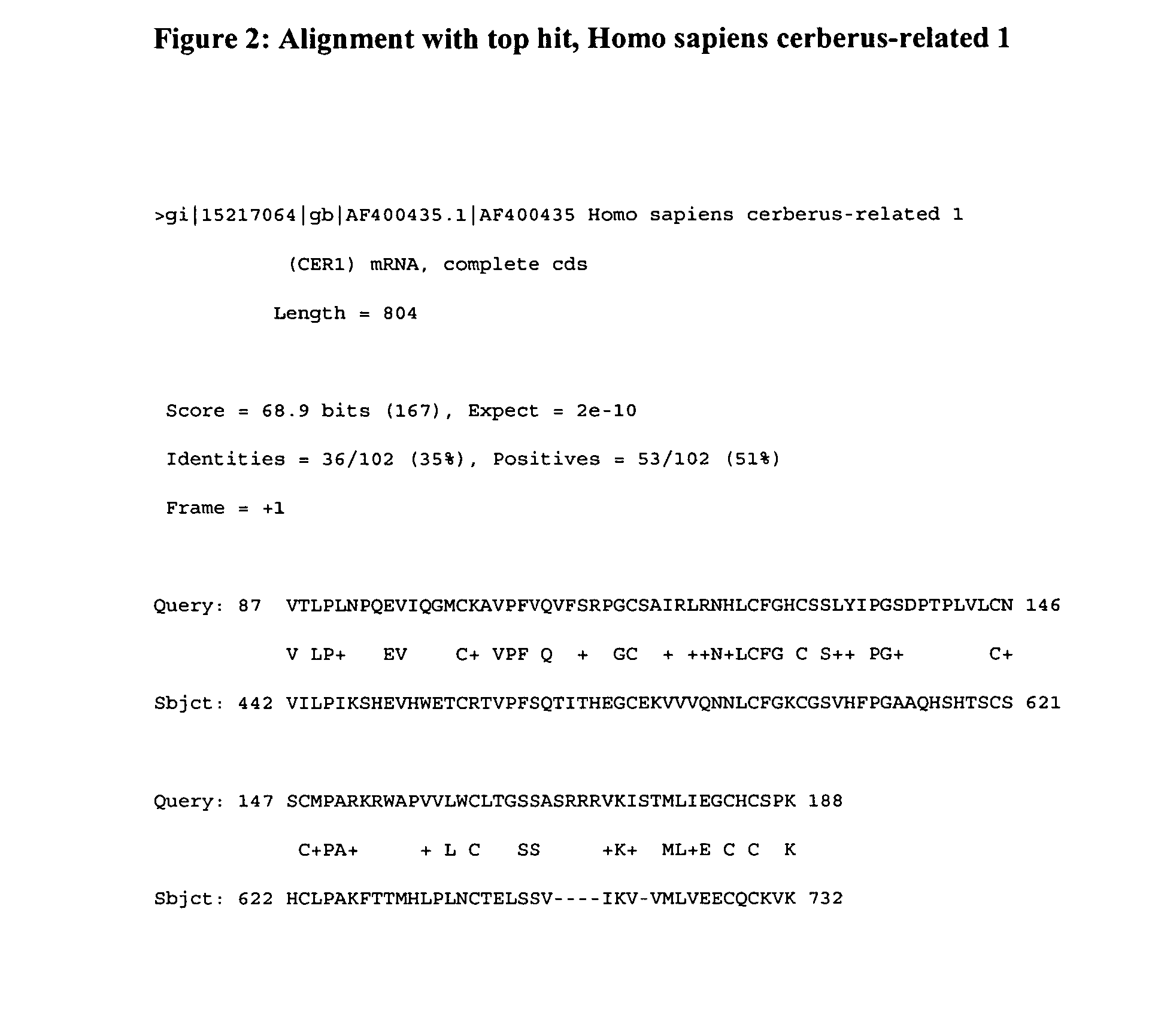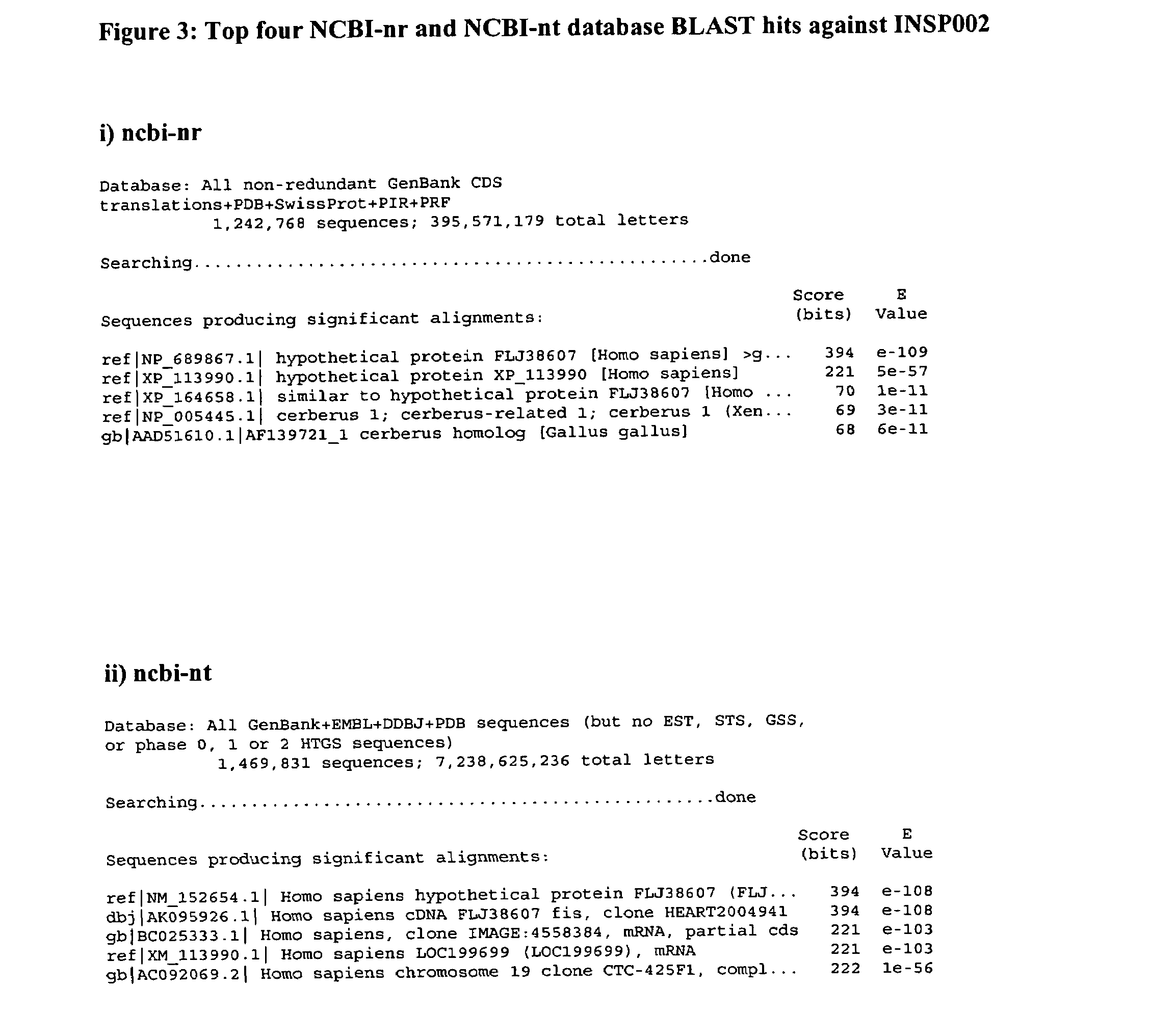Cystine-knot fold protein
a technology of cystine-knot and fold protein, which is applied in the direction of peptide/protein ingredients, dna/rna fragmentation, fungi, etc., can solve the problem that bmp is no longer able to interact with its cell surface signaling receptor
- Summary
- Abstract
- Description
- Claims
- Application Information
AI Technical Summary
Benefits of technology
Problems solved by technology
Method used
Image
Examples
example 1
Comparison of INSP002 Protein with Proteins in Sequence Database
[0262]The polypeptide sequence derived from combining SEQ ID NO:2 and SEQ ID NO:4, which represents the translation of consecutive exons from INSP002 was used as a BLAST query against the NCBI non-redundant Sequence database. The top ten matches include sequences annotated as cerberus or cerberus related proteins, which are members of the cystine knot family, all of which align to the query sequence with highly significant E-values (2E−10 to 3E−06) (FIG. 1). FIG. 2 shows the alignment of the INSP002 query sequence to the sequence of Homo sapiens cerberus-related 1 protein (Feng et al. 2001).
[0263]The polypeptide sequence derived from combining SEQ ID NO:2 and SEQ ID NO:4, which represents the translation of consecutive exons from INSP002 was inputted into SignalP V2.0.b2 (Nielsen et al. 1997 Protein Eng 1:1-6). The program predicted that the polypeptide sequence had a signal peptide. The most likely cleavage site for th...
example 2
Repetition of BLAST Searches
[0265]BLAST searches of the NCBI-nr and NCBI-nt databases were conducted on 26 Nov. 2002 using the polypeptide sequence of SEQ ID NO:6, derived from combining SEQ ID NO:2 and SEQ ID NO:4. The top four hits identified by these searches are shown in FIG. 3.
[0266]The searches revealed that the INSP002 polypeptide is identical to hypothetical protein FLJ38607 at the amino acid level and the corresponding nucleotide sequence AK095926, cloned from the heart and deposited on 16 Jul. 2002. FIG. 4 shows the alignment of the INSP002 query sequence with the protein derived from the AK095926 cDNA clone.
[0267]The exon 1 and exon 2 splice junction predicted for INSP002 is proven experimentally by the existence of AK095926.
[0268]
[0269]The searches also revealed that parts of the INSP002 are identical to IMAGE clone 4558384 (BC025333.1) deposited on 8 Mar. 2002. FIG. 5 shows the alignment of parts of the INSP002 query sequence with IMAGE clone 4558384.
example 3
Partial Cloning of cDNA for INSP002
i) cDNA Libraries
[0270]Human cDNA libraries (in bacteriophage lambda (λ) vectors) were purchased from Stratagene or Clontech or prepared at the Serono Pharmaceutical Research Institute in λ ZAP or λ GT10 vectors according to the manufacturer's protocol (Stratagene). Bacteriophage λ DNA was prepared from small scale cultures of infected E. coli host strain using the Wizard Lambda Preps DNA purification system according to the manufacturer's instructions (Promega, Corporation, Madison Wis.) The list of libraries and host strains used is shown in Table I.
ii) PCR of Virtual cDNAs from Phage Library DNA
[0271]A partial cDNA encoding INSP002 (FIG. 6) was obtained as a PCR amplification product of 159 bp (FIG. 7) using gene specific cloning primers (INSP002-CP1 and INSP002-CP2, FIG. 6 and Table II). The PCR was performed in a final volume of 50 μl containing 1×AmpliTaq™ buffer, 200 μM dNTPs, 50 pmoles each of cloning primers, 2.5 units of AmpliTaq™ (Perkin...
PUM
| Property | Measurement | Unit |
|---|---|---|
| volume | aaaaa | aaaaa |
| Tm | aaaaa | aaaaa |
| temperature | aaaaa | aaaaa |
Abstract
Description
Claims
Application Information
 Login to View More
Login to View More - R&D
- Intellectual Property
- Life Sciences
- Materials
- Tech Scout
- Unparalleled Data Quality
- Higher Quality Content
- 60% Fewer Hallucinations
Browse by: Latest US Patents, China's latest patents, Technical Efficacy Thesaurus, Application Domain, Technology Topic, Popular Technical Reports.
© 2025 PatSnap. All rights reserved.Legal|Privacy policy|Modern Slavery Act Transparency Statement|Sitemap|About US| Contact US: help@patsnap.com



